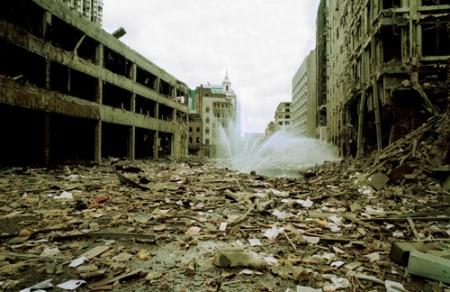Twenty-five years ago today a huge truck bomb was detonated by the Provisional IRA in the heart of London’s financial district.
It caused massive structural damage, but incredibly only one person was killed and a small number of others injured in the huge explosion. A coded warning had been received from the bombers, prompting an emergency evacuation. It was also a Saturday so the area – dominated by office buildings – held far fewer people than on a busy weekday.
 Since the beginning of its armed campaign to end British rule in Northern Ireland, the IRA had carried out a series of bomb attack in England, targeting military bases, political events and establishments and, in some cases, individuals. It also focussed on commercial premises to disrupt the economy, not just by the physical damage caused by bombs, but by instilling fear that another could explode at any time in any location.
Since the beginning of its armed campaign to end British rule in Northern Ireland, the IRA had carried out a series of bomb attack in England, targeting military bases, political events and establishments and, in some cases, individuals. It also focussed on commercial premises to disrupt the economy, not just by the physical damage caused by bombs, but by instilling fear that another could explode at any time in any location.
Planning for the bomb attack in Bishopsgate – a major thoroughfare in the City of London – had been ongoing for several months. In March, a large Iveco open-topped tipper truck was stolen in Staffordshire and repainted dark blue to disguise it. The one-tonne bomb, made in Ireland using industrial explosive and smuggled into England, was placed in the truck bed and hidden under a layer of tarmac.
At about 9am on April 24th, two men drove the truck through central London and parked it on Bishopsgate outside what was then the Hong Kong and Shanghai Bank, before being picked up by a third man in a car. The truck didn’t immediately cause alarm as building work was often carried out at weekends, but passing police officers had begun a routine vehicle check when the first bomb warning was received.
Several phone calls were made from a public phonebox in County Armagh. The caller warned of “a massive bomb”, urging the authorities to “clear a wide area”. Because the caller used a recognised IRA codeword, the warnings were taken seriously and police immediately began evacuating the area around Bishopsgate. The evacuation was ongoing when the bomb exploded at 10-27am.
The explosion was heard, and felt, throughout the capital, sending up a huge ‘mushroom cloud’ of dust and debris, and gouging a 15ft-wide crater in the street. The damage covered a 1,000-metre radius, with hundreds of thousands of windows blown out and more serious structural damage closest to the bomb. Among the badly damaged buildings was the NatWest Tower, at the time the tallest skyscraper in London.
Tucked among the modern office blocks and less that 25ft from the truck bomb, the medieval church of St Ethelburga’s was almost completely destroyed. Another nearby church and Liverpool Street underground station also suffered extensive damage.
The only person killed was 34-year-old father-of-two Ed Henty, a freelance photographer working for the News of the World. Hoping for exclusive pictures, he had rushed to the area in spite of police warning and was crushed under falling rubble. Forty-four others were injured, mostly builders, security guards, office workers and a small number of residents, who were being evacuated when the bomb exploded. Many suffered cuts from flying glass and puncture eardrums from the blast.
The cost of the damage was conservatively estimated at over £1 billion (around £2 billion in today’s money), but disruption to the City of London would go on for several months, with many businesses effectively homeless. It was a major publicity coup for the IRA, and the apparent ease with which it was carried out raised the spectre of further attacks on the capital’s financial heartland.
Just a month later plans were unveiled for a new security cordon, dubbed a “Ring of Steel”, around the City of London. Most routes into the City were closed to vehicles and the remaining ones were given new checkpoints manned at all times by armed police. An extended network of CCTV cameras was established and a scheme set up to co-ordinate between the police and the various private security companies operating in the City.
It would be the last major IRA bombing in England during that phase of ‘The Troubles’, with a ceasefire declared in August 1994. It ended in February 1996 when the IRA detonated another truck bomb, this time in London’s fast-growing secondary financial district, the Docklands. Two people were killed in the explosion at Canary Wharf. The Good Friday Agreement, designed to finally end three decades of ‘The Troubles’, was signed in April 1998.
